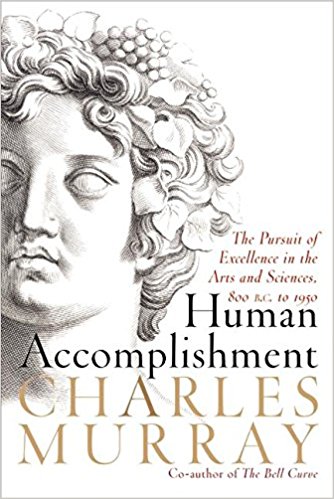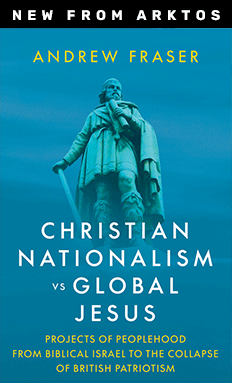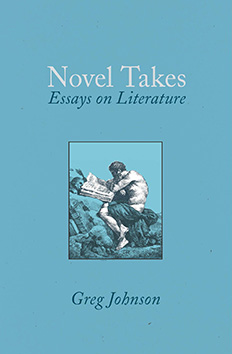Very Important People
Sam Francis, American Renaissance, May 2004
Charles Murray, Human Accomplishment: The Pursuit of Excellence in the Arts and Sciences 800 B.C. to 1950, HarperCollins, 2003, 688 pp.
Nine years after publishing The Bell Curve, one of its co-authors, Charles Murray, has produced Human Accomplishment, a mammoth examination of world history and the people Dr. Murray believes are its most important intellectual figures. His purpose is to determine who has “accomplished” the most and why they did so. While his own accomplishment is impressive in itself, some of the questions readers would have wanted answered are not even raised.

Surprisingly and disappointingly, Dr. Murray has little to say about the role of genetics in determining or facilitating “human accomplishment,” and virtually nothing (with one exception) to say about the heritability of intelligence. Instead, the bulk of his book is devoted to formulating a list of 4,002 individuals from around the world who lived between 800 BC and 1950, who “have achieved great things.” Namely, as he writes on the first page of his introduction, “They have discovered truths about the workings of the physical world, invented wondrous devices, combined sounds and colors in ways that touch our deepest emotions, and arranged words in ways that illuminate the mysteries of the human condition.”
That is what he means by “human accomplishment,” and he therefore excludes other, also impressive achievements such as military victories, the building of large fortunes, and political organization. His criteria thus rule out people like Augustus Caesar, Napoleon, Hitler, Genghis Khan, or John D. Rockefeller. In other words, “human accomplishment” as he defines it is confined to “great things” that fall “in the domain of the arts and sciences.”
Dr. Murray selected his 4,002 leading figures by surveying a large series of standard biographical and historical references (e.g., the 16 volume Harvard Biographical Dictionary of Music, the 18-volume Dictionary of Scientific Biography, etc.) and choosing people in the arts and sciences who are “mentioned in at least 50 percent” of them. The survey also includes non-Western cultures — China, India, Japan, and the Arab world — in such fields as literature, the visual arts, and philosophy. Dr. Murray’s examination of science includes non-Western as well as Western figures, at least in principle; his list of non-Western achievers in the science categories is pretty short.
Obviously the whole concept is open to predictable objections: that the selection of sources is biased or unrepresentative or otherwise inadequate, that the concept of “accomplishment” emphasizes science at the expense of other fields of achievement, that the time limits of 800 B.C. to 1950 A.D. also skew the results and are also arbitrary. The early time limit excludes not only Pharaonic Egypt and most of the ancient Mesopotamian civilizations but also the early Chinese and Indian civilizations, while the 1950 limit can be accused of eliminating non-whites, women, and other fashionable victim groups that today are widely believed to have been emancipated only in our own enlightened decades. Predictably, these objections were the first to be made in the reviews of Human Accomplishment, and throughout the book (indeed, far too much so) Dr. Murray responds to these objections and does a pretty good job of it.
You can quibble with the methods and standards by which Dr. Murray came up with his 4,002 individuals, and you can criticize the book for ignoring less cerebral but arguably even more significant accomplishments such as the defeat of Persia by the Greeks, the destruction of Carthage by Rome in the Punic Wars, the organization of the Roman Empire or the Catholic Church, the founding and rise to power of such institutions as IBM, AT&T, or La Cosa Nostra, and other non-intellectual achievements. And even if you accept the methods and standards Dr. Murray uses, you can question the particular accomplishments and those who made them. Does the Marquis de Sade really belong in the inventory of “Human Accomplishment” in Western literature regardless of how many encyclopedias carry entries for him? Does Arthur Conan Doyle? Is the invention of the steam engine, for all its world-historical significance, on a par with the formulation of Newton’s Laws of Motion or Aristotle’s logic? Dr. Murray doesn’t say it is, but all are included in the “human accomplishment” index, and there seem to be any number of such disparities in “accomplishment” as he has defined and measured it.
In any case, the results of his survey are predictable. White European men predominate, especially in the last few centuries: “from the middle of 15C [Dr. Murray’s rather contrived abbreviation for “15th century”] to the beginning of 20C, almost everything came from Europe,” and, “What the human species is today it owes in astonishing degree to what was accomplished in just half a dozen centuries by the peoples of one small portion of the northwestern Eurasian land mass.” On page 297, Dr. Murray has a map of the European peninsula showing where those responsible for Western accomplishments grew up, and the region it describes is of interest.
“If we ignore national borders,” he writes, “and instead create the most compact polygon that encloses 80 percent of the places where the significant figures grew up, it forms the shape in the figure below, with borders defined by Naples, Marseilles, the western border of Dorset County in England, a point a few miles above Glasgow, the northern tip of Denmark, and a point a few miles east of the city that used to be Breslau in German Silesia (now Wroclaw in Poland).”
This is the “European Core” as Dr. Murray calls it. It is also more or less the core area of the Nordic subrace in Europe.
Of the 4,002 important people Dr. Murray surveys, women constitute a mere 88, and nearly half are in literature. There are a number of non-Westerners like Arabs, Indians, and Chinese on his list, but Africa and the Negro race are not even a blip. No gushing about the mind-boggling achievements of George Washington Carver here. Dr. Murray has a brief discussion of the possible role of IQ in accounting for why males so vastly predominate over females, though he doesn’t think it’s significant.
For the remainder of his book, the co-author of The Bell Curve doesn’t mention IQ, race, or genetics — except with reference to one group: Ashkenazi Jews. As he explains:
The rapid pace at which they entered the inventories as soon as the barriers were even partially lifted is astonishing. The period 1870-1950 saw the addition of 1,277 significant figures to the Western inventories. If Jews had produced significant figures strictly in accordance with their representation in the population, about 28 of those 1,277 should have been Jewish. The actual number was at least 158 (data on ethnicity were not available for many of the less prominent significant figures, and some Jews have doubtless been missed).
Dr. Murray devotes two pages to discussing how the higher Jewish IQ may account for this level of achievement. I have no reason to challenge his interpretation or his attribution to Jews of a far more significant role in human accomplishment than their numbers would suggest, but there are questions to be raised. First, as Dr. Murray acknowledges in a footnote, he has counted as Jewish anyone who has one parent who was known to be Jewish; to what degree has that definition expanded the number of Jews in his lists? Second, why did Jews contribute almost nothing to human accomplishment before the 19th century? We can count the Old Testament (which has had an influence in the West because of Christianity), a handful of secular Jewish writers of antiquity, the medieval philosopher Moses Maimonides, the 17th century philosopher Baruch Spinoza, and the 18th century composer Felix Mendelssohn and his father, a prominent philosopher of the time, and a few others, but that’s about it.
Dr. Murray names only 11 Jews in his inventories before “19C.” If Jews are so smart, why didn’t they invent logic, the calculus, or the steam engine or crank out such masterpieces as The 120 Days of Sodom or The Hound of the Baskervilles?
Dr. Murray’s answer is that they were persecuted and excluded, and no doubt that’s part of it, but a good deal of Jewish culture discouraged innovation and scorned interaction with the gentile world, whether it was receptive to non-Christians or not. Spinoza, after all, was excommunicated by the Jewish community in Amsterdam for his philosophy. In the case of some “half Jews” like the writer Michel de Montaigne, whose mother was a Spanish Sephardic Jew, he was accepted into gentile society as a practicing Catholic. It was their adherence to their religion in an orthodox Christian culture that both kept Jews from participation and caused their exclusion.
It is not entirely clear why Dr. Murray is prepared to invoke IQ in discussing Jews but says nothing about it as an explanation for the level of accomplishment (or non-accomplishment) by other groups. Dr. Murray in fact resorts to a purely cultural explanation as to why the West — the white race from ancient Greece to modern times — has accomplished most of what has been worth accomplishing. In both Greek philosophy from the time of Aristotle and in medieval Christianity, the West embraced the belief that life has a purpose. “A major stream of human accomplishment,” Dr. Murray writes, “is fostered by a culture in which the most talented people believe that life has a purpose and that the function of life is to fulfill that purpose.” But purpose itself, he says, is not enough; there must also be “autonomy,” the belief that one is able to achieve the purpose of his life, a belief that involves a high degree of individualism. The non-West lacks or even rejects such beliefs.
Buddhism and Daoism (Chinese Taoism), he says, lacked both purposiveness and autonomy. “Both [religions] taught that purposeful action in one’s life is a snare and delusion . . . It is safe to say that neither Buddhism nor Daoism was a religion calculated to energize people to fulfill a purpose in this life on earth,” and individualism and autonomy were smothered by “familistic” and “hierarchical” social and cultural constraints. Islam insisted on a high and inexorable purpose but flunked the autonomy test, with its insistence on an ironclad fatalism. Arabic culture in the Middle Ages at first embraced Greek and Western science and philosophy but later rejected them in favor of an Islamic fundamentalism that, according to Dr. Murray, has kept the Arabic world behind ever since. Only in the Aristotelian Christian West was a cultural norm of a purposive life and the autonomy to achieve it institutionalized.
Dr. Murray’s argument is plausible as far as it goes, and he is hardly the first to make it. But he never wonders why it was only the West that formulated and adopted philosophies, ethical systems, and a religion that postulated purpose and autonomy. Kevin MacDonald has argued that Western individualism itself has genetic and racially particular roots, and if Dr. Murray’s theory about the importance of belief systems of purpose and autonomy holds any water, the genetic and racial foundations of such systems ought to be examined.
Dr. Murray concludes Human Accomplishment on a pessimistic note. Human accomplishment as he has defined and measured it has been declining in both science and the arts for the last century or so. After several pages of considering alternative explanations for the decline, Dr. Murray concludes, “Western European culture had a coherence in its values and institutions that did in fact begin to come apart during 18C [the 18th century], prompted by the Enlightenment and the Industrial Revolution.” The disruption of Western cultural coherence helped undermine the belief systems of purpose and autonomy, and the intellectual legacy of the late 19th and 20th centuries in what he calls “nihilism,” the denial that life has a purpose or that human beings can achieve it. The thought and influence of figures like Charles Darwin, Friedrich Nietzsche, Sigmund Freud, Albert Einstein, and Jean Paul Sartre helped finish off what coherence remained.
Although Dr. Murray regards religion as essential to human accomplishment, his concept of religion includes such things as Confucianism and Aristotelianism. He writes:
Confucianism and classical Greek thought were both essentially secular, and look at the cultures they produced. But both schools of thought were tantamount to religion in that they articulated a human place in the cosmos, laid out a clear understanding of the end — the good — toward which humans aim, and set exalted standards of human behavior. And that brings me to the sense in which I use religion stringently. Confucianism and Aristotelianism, along with the great religions of the world, are for grownups, requiring mature contemplation of truth, beauty, and the good. Cultures in which the creative elites are not engaged in that kind of mature contemplation don’t produce great art.
In the end, it’s not clear what Human Accomplishment really accomplishes. Dr. Murray, by any reasonable standard, has shown that Western white men have produced most of human civilization, but we already knew that, and those of us who didn’t will refuse to learn it from Dr. Murray. We also know that our civilization is in decline, and Dr. Murray has something to tell us about why, though what he has to say is in my view incomplete. His portrait of cultures that encourage or discourage human accomplishment is far too over-drawn and needs a good deal more detailed discussion of how the religious and philosophical frameworks helped or harmed creativity, and his correlations between them are not always at all clear. Dr. Murray should have expanded his chapters on those themes considerably, but that would no doubt have taken him off in directions in which he doesn’t want to go.
Finally, Dr. Murray’s book is not particularly interesting to read. He spends far too much time batting back and forth possible objections to his arguments and explaining his statistical methodologies, and he also has tendencies to pontificate about matters largely irrelevant to his argument, and to lecture readers about what should be high-school history and general science. Most of all, however, Charles Murray is one of the relatively few mainstream writers capable of telling the declining Western world something important about the racial foundations of its civilization and why that foundation is beginning to crumble. The greatest failure of this book is that he hasn’t done it.















